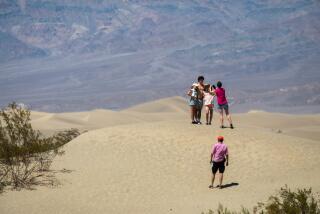Death Valley Daze : Golf Below Sea Level: It’s Where Coyotes Prowl and Bobcats Play
- Share via
More than 200 feet below sea level lies a truly unique golf experience--winsome Death Valley, the world’s lowest golf course.
That’s low as in elevation, not golf score. For adventurous players, these are a few of the unusual obstacles at the Death Valley Golf Course:
Coyotes that run off with your drive, sure that that skittering little ball is a meal in disguise.
Bighorn sheep wandering in from the canyons to say their final prayers on this 90-acre desert oasis, falling over dead on one of the greens.
And a wily little family of bobcats that live by hole No. 5.
Luckily, it’s not summertime here, when the temperatures regularly soar into the 120s by day and drop to a tepid 100 by night. In summer months, the course is closed after noon because of the extreme heat and cattle may be driven across the course, once an alfalfa field, by real live cowboys.
The National Park Service, of course, frowns on that practice now. It seems some errant cattle made a mess of the nearby Death Valley National Park Center with an impromptu party when the cowhands went into the Furnace Creek Ranch bar for a few thirst-quenchers.
*
The course is a 6,093-yard par 70 at the bottom of Death Valley. Off the Bermuda grass fairways is desert hard-pan studded with kangaroo rat holes, tufts of blond grass and hardy creosote bush.
The resident pro describes the layout with a wink as “a short, flat, placement-type course, well-treed, with small greens . . . an 18-hole golf course in the middle of a national park.”
What Rick Heitzig, an affable club pro from Reedsport, Ore., doesn’t say is that six of the first nine holes have water hazards where the geese and coots and other birds in their winter flyway congregate: sitting ducks, you might say, for hungry coyotes.
On the sixth hole, a young coyote suddenly streaked across the fairway and chased some coots as they scooted into the water bordering the green on the adjacent fifth.
One doesn’t normally associate the harsh, desert terrain of Death Valley with water but there are spring-fed ponds and creeks aplenty. Salt cedar trees and date palms frame the fairways, bunches of orange fruit hanging heavy.
Dates that fall from the palms are a favorite dessert treat of the coyotes.
The coyotes’ main meal are the coots and ducks and other birds that splash happily at the golf course, perhaps startled to find pools of water in this huge swath of desert 140 miles west of Las Vegas.
Startling, too, are the bird-watchers that flock here, a major north-south fly zone for snow geese, various species of hawks and owls and other avians. A few of the bird-watchers don’t recognize the boundaries of the golf course, stumbling across fairways while golfers hit, binoculars glued to their eyes.
“To the real true-to-the-bone bird-watcher, this is a mecca,” said Heitzig, who has worked at the course for six years. “It’s a funny thing, not a bad thing. Nobody’s been hit--yet. The (golf course) marshals patrol the course, kind of direct them to safer areas.”
The course dates to 1925 when a caretaker at the former Greenland Ranch made three holes for desert visitors. By the 1950s, it became a 9-hole course and later 18 as more and more people, perhaps attracted to the area by the popularity of the radio and TV series “Death Valley Days,” visited.
The Western series, some of them filmed on location here, was originally hosted by “the old Ranger” Stanley Andrews and then by former President Reagan for two seasons before he was elected governor of California in 1966.
Incidentally, the term “Death Valley days” was coined by one of the original surviving homesteaders who had been trapped in the sweltering valley in 1849. Historians say one of the women, as she looked back at the area before leaving for safety, was heard to utter: “Goodbye, Death Valley.”
But the place has its own kind of beauty. In the morning, the sun shines pink in the distance off the snow-dusted Panamint Range that rises to 11,000 feet over the desert.
More to Read
Sign up for The Wild
We’ll help you find the best places to hike, bike and run, as well as the perfect silent spots for meditation and yoga.
You may occasionally receive promotional content from the Los Angeles Times.






